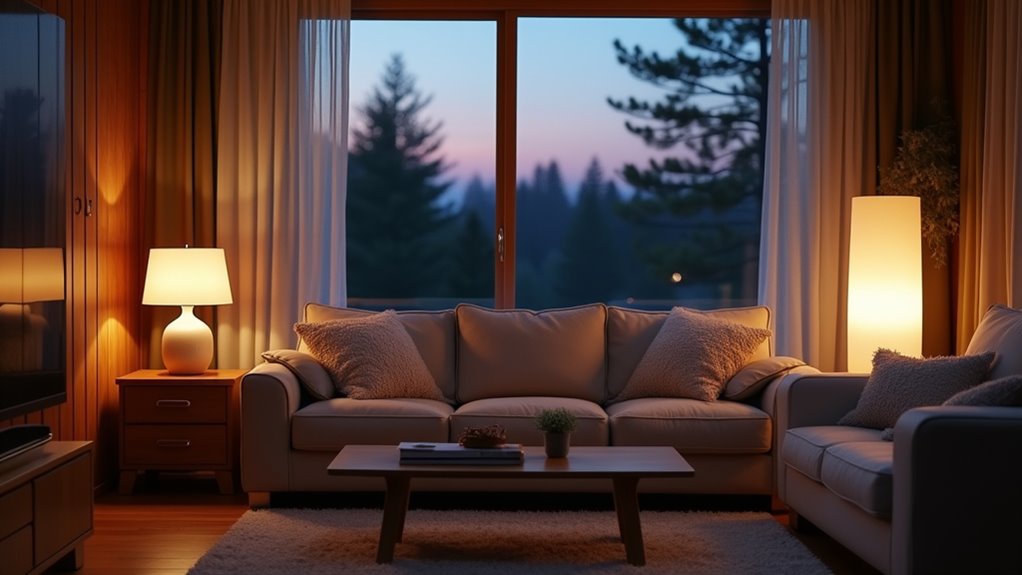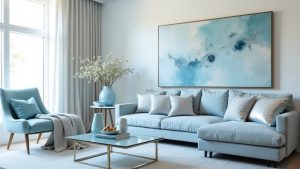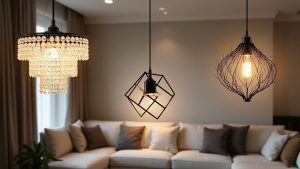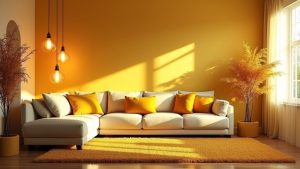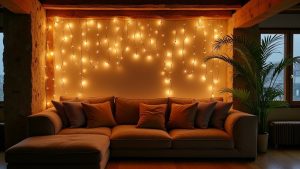Choosing between warm or white light for a living room involves crucial factors such as color temperature, emotional impact, and aesthetic harmony. Warm light fosters comfort and relaxation, enhancing social gatherings. In contrast, cooler white light promotes focus and alertness, suitable for productivity zones. Additionally, the interplay with decor and color can dramatically alter the ambiance. Adjustable lighting options and energy-efficient bulbs further enhance functionality and style. Exploring these considerations can transform your living space beautifully.
Key Takeaways
- Consider the overall decor style: warm light complements traditional designs, while white light enhances minimalist aesthetics.
- Identify primary activities: choose warm light for relaxation and social spaces, and white light for productivity-focused areas.
- Utilize layered lighting solutions to combine ambient and task lighting, ensuring flexibility and enhancing the room’s functionality.
- Experiment with adjustable lighting to customize ambiance and energy efficiency, allowing for tailored lighting intensity as needs change.
- Remember energy efficiency: opt for LED bulbs in either temperature, providing long-lasting illumination with significant energy savings.
Understanding Color Temperature

Although many people may simply choose a light bulb based on brightness, understanding color temperature reveals a deeper layer of lighting design that significantly impacts ambiance and mood.
Color temperature, measured in Kelvin (K), influences color perception and varies from warm yellows at lower values to cool blues at higher ones. For instance, light sources below 3000K emit a comfortable, inviting glow, ideal for living spaces, while those exceeding 4500K provide bright, energizing illumination suitable for tasks. Color temperature typically ranges from 2200K to 6500K, offering a variety of options to suit different preferences. Heating a metal object demonstrates how color changes with temperature, further illustrating the concept of color temperature in lighting. It’s important to consider how darker wall colors might require more lumens to achieve the same level of perceived brightness in a room. Incorporating dimmable LED bulbs allows for personalized adjustments in light settings, making them a versatile choice in living room design.
Color temperature, measured in Kelvin, dramatically influences ambiance, with warm yellows fostering comfort and cool blues enhancing focus.
Moreover, the concept of correlated color temperature (CCT) allows a more nuanced selection, ensuring that different light sources, regardless of their type, can blend harmoniously.
A thoughtful approach to color temperature will elevate the atmosphere of any room, enhancing overall enjoyment.
The Impact of Light on Mood

How does the quality of light in a living room shape emotional well-being? The careful selection of lighting—whether warm or cool—can significantly influence mood enhancement and emotional stability. Warm lighting, often embraced in light therapy, promotes relaxation and comfort, creating an inviting ambiance that fosters social interactions. In contrast, cooler tones enhance alertness and productivity but may disrupt emotional regulation, particularly before bedtime. Understanding color psychology reveals that yellow hues evoke happiness, while saturated colors can amplify emotions, contributing to overall mood regulation. Incorporating natural wood finishes and understated upholstery into your design helps create a comfortable, serene environment that complements the lighting choice. Additionally, incorporating relaxation techniques alongside proper lighting can optimize one’s living environment. Incorporating a light and reflective color scheme into your living room’s design can also enhance brightness and improve mood, turning the space into an inviting sanctuary. Ultimately, the right light transforms a living room into a sanctuary, shaped by environmental influences and promoting emotional wellness.
Choosing the Right Light for Activities

What guides the choice of lighting for various activities within a living room? For tasks such as reading, focused illumination is essential to minimize eye strain, favoring warm yellow light (2700K-3000K) for relaxed settings and cooler white light (4000K-6000K) for study.
Floor lamps or wall-mounted fixtures should be strategically placed to direct light onto reading material without glare or shadow.
In contrast, lighting for sleeping necessitates a softer ambiance, where warm, diffused light promotes a peaceful atmosphere.
Dimming capabilities enhance flexibility, allowing for softer lighting during wind-down periods.
Layered Lighting Solutions

Layered lighting solutions transform a living room into a multifaceted space by strategically combining ambient and task lighting options.
Ambient lighting sets the foundational glow that ensures both warmth and safety, while task lighting sharpens focus on specific activities, enhancing functionality.
Together, these layers create a harmonious environment that adapts to various moods and needs, making the living room both inviting and practical.
Ambient Lighting Options
While ambient lighting serves as the foundational layer of illumination in a living room, its true effectiveness is achieved through thoughtful layering of various light sources.
Utilizing diverse ambient light sources, such as ceiling-mounted fixtures, wall sconces, and table lamps, creates a dynamic atmosphere. Light layering techniques, involving both height and location variations, offer depth and richness to a space.
An overhead fixture can serve as the primary light, while strategically placed floor lamps accentuate cozy corners. Employing dimmer switches provides flexible light intensity, adapted to different activities.
This cohesive approach not only reduces glare and shadows but also enhances the overall warmth and invitation of the living room, ensuring a comfortable environment that encourages relaxation and social engagement.
Task Lighting Considerations
An effective living room design seamlessly incorporates various layers of lighting, and task lighting serves a crucial role within this framework. It provides focused illumination for specific activities, enhancing both concentration and comfort.
Optimal task light placement is essential, allowing for functional zones to emerge effortlessly.
Consider these key fixture types:
- Floor Lamps: Perfect for reading nooks with adjustable lighting.
- Table Lamps: Versatile for illuminating surfaces like desks and side tables.
- Wall Sconces: Efficient for smaller spaces, saving floor area while defining task areas.
These thoughtfully chosen task lights enrich the living room’s functionality, creating brighter, more inviting spaces where family and guests can engage in activities without eye strain or distraction.
Interaction With Decor and Colors

The interplay between light and decor significantly influences the ambiance of a living room, as variations in color temperature can enhance or mute the inherent qualities of furnishings and wall colors.
Warm light, ideal for traditional or rustic styles, augments warm-toned fabrics and natural materials, creating inviting decor style interactions. In contrast, cool white light suits minimalist decor, making cool colors appear vivid while highlighting sleek surfaces like glass and metal.
This color synergy becomes crucial when considering wall paint; warm hues glow richly under warm light, whereas cooler shades come alive under cool light.
Choosing the appropriate light temperature can dramatically transform a room’s atmosphere, ensuring that the chosen decor resonates harmoniously with its environment.
Room Size and Natural Light Considerations

Room size and natural light availability significantly influence the choice of lighting in a living room, as these factors dictate both the ambiance and functional aspects of the space.
- Small room preferences: Warm white light (2700K-3000K) creates a cozy atmosphere, enhancing intimacy in confined spaces.
- Large room adaptations: Cooler light (up to 4100K) helps reduce shadows and amplifies the spaciousness, while warm tones can provide a snug feel.
- Natural light considerations: Rooms with abundant light can benefit from warmer bulbs for evening warmth, while those lacking sunlight may need brighter, cooler options to counteract darkness.
Understanding these dynamics ensures the perfect lighting harmonizes with the room’s characteristics, making every living area resonate with comfort and style.
Functionality vs. Aesthetics

In the intricate balance of designing a living room, the interplay between functionality and aesthetics is paramount.
Practical lighting needs dictate choices that enhance visibility for various activities, while visual appeal influences the room’s overall ambiance and comfort.
Striking the right equilibrium not only elevates the space’s practicality but also enriches its charm, creating an inviting atmosphere tailored to both tasks and relaxation.
Practical Lighting Needs
While balancing functionality and aesthetics may seem challenging, achieving the right lighting in a living room is key to enhancing both comfort and practicality.
The task definition of each space impacts energy needs and determines suitable lighting selections.
Consider these essential lighting areas:
- Reading Nooks: Warm white light (2700K-3000K) for cozy reading or cooler hues (3500K-4000K) for focus.
- Hobby Areas: Neutral to cool lighting (3500K-5000K) enhances detail for crafts or puzzles.
- Work/Study Zones: Cooler white light (4000K-5000K) boosts productivity.
Incorporating these elements thoughtfully serves practical needs without sacrificing the room’s overall charm, creating a balanced environment where functionality meets inviting design.
Visual Appeal Factors
Achieving a harmonious balance between functionality and aesthetics in living room lighting not only elevates the visual experience but also shapes the emotional ambiance of the space.
Warm light infuses a cozy warmth, complementing earth tones and enhancing the richness of furnishings, while casting soft shadow effects that highlight intricate lighting textures.
In contrast, cool white light introduces a vibrant brightness, ideal for modern, minimalist spaces, yet risks creating a harsh environment.
Effective lighting design harmoniously intertwines these elements, ensuring practicality in illuminating artworks and features.
Personal Preferences in Lighting

How does one select the perfect lighting to complement a living room’s ambiance? Personal preferences play a crucial role in choosing between warm and white light, as individual styles dictate how spaces feel and function.
When considering lighting preferences, factors include:
- Comfort Level: Warm lighting fosters intimacy, while cool light enhances productivity.
- Activity Needs: Readers require ample task lighting, while movie enthusiasts benefit from softer options.
- Cultural Influences: Backgrounds shape perceptions; some prefer the elegance of white light, others lean toward warm tones.
Adjustable Lighting Options

Adjustable lighting options transform a living room into a versatile space, allowing for tailored ambiance tailored to various activities and moods.
By incorporating fixtures such as recessed lighting, track lights, or stylish pendant lamps, homeowners can highlight features and create focal points that enhance both aesthetic appeal and functionality.
The ability to customize light intensity and direction not only elevates the atmosphere but also promotes energy efficiency, making adjustable lighting a wise investment for any home.
Benefits of Adjustable Lighting
While many homeowners seek to enhance their living spaces, the benefits of adjustable lighting often stand out as a transformative element in interior design.
By utilizing smart technology, adjustable lighting empowers individuals to craft their ideal ambiance through:
- Mood Enhancement: Warm lights create a cozy atmosphere for unwinding, while cool lights invigorate for daytime activities.
- Versatile Functionality: Tailored lighting accommodates various tasks, from reading to entertaining, adapting to different needs effortlessly.
- Energy Efficiency: Dimmable options lead to reduced energy consumption, lowering electricity bills and extending bulb life.
This flexibility in ambiance control not only enhances aesthetics but also positively affects well-being, supporting emotional health and vitality in everyday life.
Types of Adjustable Fixtures
What choices does one have when it comes to selecting adjustable lighting fixtures that elevate both functionality and aesthetics?
Recessed lighting offers a sleek appearance, with features that allow light to pivot, enhancing architectural elements or artwork.
Track lighting systems provide flexibility, letting users reposition fixtures along a track for tailored illumination.
Smart fixtures redefine convenience; remotely controlled via apps or voice assistants, these lights allow for dynamic adjustments in brightness and color temperature, creating various atmospheres.
Complementing these options, portable lamps, including desk and floor varieties, feature adjustable arms for precise positioning.
Together, these lighting solutions create a harmonious blend of practicality and design, perfect for any living room setting.
Customizing for Activities
How can the right lighting transform a living room into a multifunctional haven?
Customizing for activities through adjustable lighting options fosters a vibrant environment tailored to diverse needs.
Consider these three aspects of activity-based lighting:
- Reading: Utilize focused, warm lights to create a cozy nook.
- Socializing: Employ dimmers to adjust ambiance for lively gatherings.
- Working: Incorporate cooler, brighter lighting to enhance productivity.
Energy Efficiency and Bulb Choices

When considering energy efficiency in lighting choices, the decision between warm and cool white bulbs often leads to a deeper exploration of available technologies.
LED bulbs have emerged as the most energy-efficient option, utilizing 85-90% less energy than traditional incandescent bulbs. Crucially, the color temperature does not dictate energy consumption; both warm and cool white LEDs consume the same wattage. However, cooler LEDs can marginally enhance energy savings due to their production efficiencies.
LED bulbs are the top choice for energy efficiency, consuming 85-90% less energy than incandescent while maintaining consistent wattage across color temperatures.
Notable for their impressive bulb lifespan, ranging from 25,000 to 50,000 hours, LEDs reduce the need for frequent replacements, further decreasing costs over time.
Ultimately, selecting LEDs ensures maximized illumination while minimizing energy expenditure, creating a cost-effective lighting solution for any living room setting.
